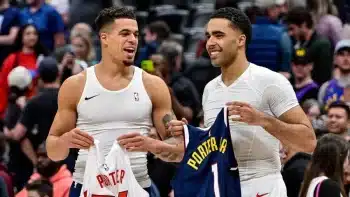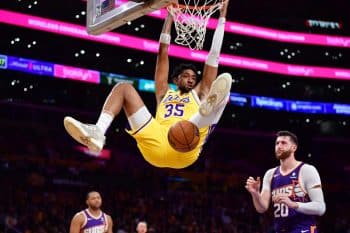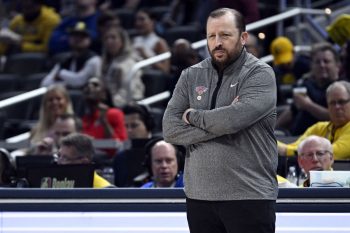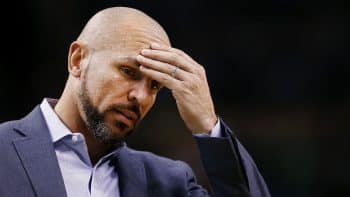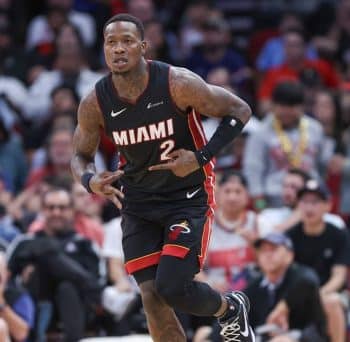NBA Draft
The Young Stars of the adidas Eurocamp
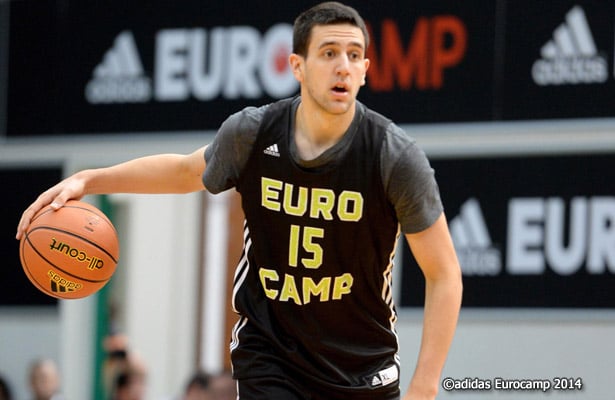
The 2014 adidas Eurocamp in Treviso, Italy was notable for the massive amount of young talent present. The shoe company was able to bring over the best talent from the inaugural season of its Gauntlet all-star circuit, including a number of top-20 prospects in the 2015 and 2016 high school classes. The Eurocamp also featured intriguing young talent born in 1998 and 1999 in the Next Generation group of players who practiced separately. Today we will examine the best of these younger players, saving this year’s potential NBA draftees for a few days hence.
Thon Maker
Class of 2016 seven-footer Thon Maker has been compared to both Kevin Durant and Kevin Garnett due to his thin frame and shooting ability, but aside from borrowing KD’s rip through move neither of those comparisons particularly holds water. Maker is much less athletic than either comparison, and as a result is not much of a rebounder or shotblocker at this stage despite standing 7’0 with a 7’2 wingspan.
Maker’s strengths start with his jump shot. He has a pure and easy release, and already possesses the smoothness and footwork to shoot off the pick and pop with range. Maker did not quite appear comfortable shooting from NBA three-point range in Treviso, but was money out to the college line and should have no problems extending his range in time. He was also effective scoring in isolation, although he struggled to create separation. He was not able to get by his man to the rim, and often would pick up his dribble in midrange after an unsuccessful attempt to back down–and then hit a nearly impossible shot anyway. Maker drained a number of attempts where he was chested off balance by the defender, and also unveiled a Dirk Nowitzki one-legged fadeaway. It got to the point where it was surprising if he missed a jumper, no matter how difficult the attempt.
The Sudanese native also showed some nice passing ability out of the post, finding shooters on the weakside a couple of times. That was noteworthy on a U.S. team that had a mere eight assists in a 119-85 loss to the Eurocamp All-Stars. Another strength was his lateral quickness. He had absolutely no problems staying with guards either hedging or straight switching the pick and roll, and his defensive intensity was solid for someone of his experience level. In fact, he appeared to be a leader on the US team, as he was the most active calling out the plays and directing his teammates.
Maker’s biggest problem, and by extension that of this U.S. team, was his inability to block shots or rebound. That was not due to lack of effort, as he made consistent efforts to challenge shots, fight in the post and hit the glass. He just came up short due to his physical limitations, as he would have rebounds ripped out of his hands, barely miss shot blocks and get backed down by players weighing up to 50 pounds more than him. Consequently, the US team gave up 54 percent offensive rebounding and a 138 offensive rating to the Eurocamp All-Stars and got similarly bludgeoned by the French U-20 team and Canadian National Champions Carleton University.* In the game against the Eurocamp All-Stars, Maker had one defensive rebound and zero blocks in 31 minutes.
*Due to the five years of college eligibility in Canada, this team featured many mature 21-24 year olds. Although they didn’t really play anyone over 6’7, their experience, three-point shooting and solid defensive system under coach Dave Smart was extremely effective. They dropped 14-36 threes on the US team that was not remotely used to guarding the NBA three-point line.
Maker also showed little ability to get to the basket, and was not the greatest finisher on the rare occasions US guards were able to get him the ball there. He has average explosiveness and wasn’t really able to turn it over and dunk despite a few attempts.
His ability to put on weight and improve his floor game is the biggest variable in whether he can fulfill the top-ten or even top-five aspirations many have for him. He will never have the heft to be a center, but he needs to be playable at the four to really take advantage of his amazing jump shot for his size. If he can hold up in those areas, he should be a major weapon out of the pick-and-pop, although he may never have the quickness or strength to be a superior isolation or post up scorer even if he can hold up well enough on D. That is why his ceiling seems more top-ten pick than top-five, and why his ranking as the number one recruit in the 2016 class is optimistic. It should also be noted that his February 1997* birthday would normally place him in the class of 2015, and there is talk he may in fact reclassify. But the comparatively early birth date must be included in computing his ceiling.
*Some scouts have expressed skepticism over his birth date due to his Sudanese origin, but the fact he moved to Australia at age five (presumably before anyone would have realized an incentive to lie about his age) somewhat assuages those concerns. EDIT: One NBA front officer made a good point to me, namely that Maker conveniently started kindergarten at the requisite “age five” in Australia upon emigrating. Coming from war-torn Sudan, it is quite possible that neither he nor his parents know his precise age and he was started in school at the age that made the most sense.
Dragan Bender
We first saw Bender as a 16 year-old on the adidas Next Generation team of younger prospects last year. He recently signed a seven-year contract with Maccabi Tel-Aviv (NBA out unknown). As the youngest participant in the main camp this year, Bender largely played the four and struggled. He was willing to take outside shots but largely did not hit them, with some pretty bad misses. The Croatian appeared to be a bit of a thumber, i.e. he uses his thumb on his left hand while shooting. This leads to inconsistency, and he had a number of misses left or right.
Bender has grown some since last year, standing 6’11 with a 9’3 standing reach and 7’1 wingspan. He remains a rail thin 202 pounds, and struggled to bang inside. He did show small flashes on the offensive glass and some passing ability, but overall did not appear to have much chance of scoring aside from what was created by others. And he of course had trouble finishing inside due to his frame, as he was often bumped off course on the way to the rim.
Bender appeared to be pressing, especially with his jump shot.* At this stage he is more effective using his length to affect shots and filling in the gaps offensively while letting the game come to him. It must be emphasized that he is by no means a stiff at his height, with solid mobility and the ability to get into a stance defensively while seeing if not necessarily successfully executing advanced passes at times. He possesses the ability to grab and go at the lower levels as well, though we saw little of that from him here.
Bender should develop nicely in Maccabi’s system, especially if they can put a little weight on him. Dominant scoring does not appear to be in his future, but if he can become a threat from downtown and his floor game fills out he could be an NBA prospect as a stretch four.
*Granted, he was shooting like he expected to make them, so perhaps he usually does more often.
Dennis Smith
Smith had a lethargic first two days of the camp, leading me to tweet that the 6’2 point guard was less athletic than advertised. The North Carolina 910 area code native (as he trumpets on his Twitter) also struggled to get much going from a playmaking perspective, and unsurprisingly got torched in the pick-and-roll by point guards three and four years his senior. His attitude and body language were not the best either, and as one of the younger players he was unable to provide the typical leadership from the point.
But Smith had a much better showing offensively against Carleton University on Monday, getting to the rim against the packed in defense while showing nice change of direction on his jump stop and solid extension when finishing off two feet. His one foot jump is less impressive though. Overall he has above-average but not blinding quickness and ballhandling moves. He has solid form on his jump shot even out to the NBA three-point line, although he struggled overall on jumpers because he had to take some bad ones with the unfamiliar 24 second shot clock running down.
It should be noted that Smith is only a rising high school junior, with a class-appropriate November 1997 birthday. He may grow another inch or two, which would be a real game-changer for him as a prospect. But even at his current size he certainly has eventual first-round potential.
Brandon Ingram
The excitement about Ingram comes much more from his potential than what he was able to do on the court in Treviso. At a listed 6’8, 180, he simply did not have the strength to get anything done playing against men. His frame makes Dragan Bender look like an Adonis. Skill-wise, Ingram was able to hit some tough jumpers, and showed great extension on a few finishes when he was able to catch the ball inside. But Ingram was a total nonfactor on the glass, in the passing lanes and blocking shots, all of which were disappointing given his length. He can’t really get up off two feet. His lateral quickness and explosiveness off the dribble were below average in this setting as well, but his length and smooth shot provide some projectability. To mature into an NBA prospect he will need to hit the squat rack and consume 1,000 protein shakes over the next year.*
*I am not saying that to be flip; three 50 gram protein shakes per day is about what a kid like Ingram needs.
Kobi Jordan-Simmons
Others were wowed by Jordan-Simmons’ potential, but the July 1997-born point guard was less impressive to me based on his performance here. The case for Jordan-Simmons begins with his listed 6’5 height/wingspan and what appeared to be solid shooting ability on just a few attempts. But he struggled to bring the ball up against pressure by his intense but relatively slow (by NBA standards) opponents. He really was not able to get by anyone into the lane, and did not show particularly impressive hops either. His very thin frame is likely to max out at a Jamal Crawford level at best, but he doesn’t appear to have that kind of handle or athleticism. Maybe I caught him on a bad few days, but it was difficult to see what the fuss was about.
Top ranked High schooler Jaylen Brown talks about playing in front of NBA GMs, traveling to Italy and whats next for his blossoming career.
Jaylen Brown
Atlanta native Jaylen Brown leaped off the court as by far the best prospect at the Eurocamp. Brown has Stanley Johnson’s haircut and a similarly strong body, but he is a much better prospect due to his superior ball skills and explosion. Brown looked like a sure top-ten pick and possible contender for the top-five in 2016, revealing no worrisome weaknesses in his two games in Treviso. The story starts with his excellent physical profile, standing a legitimate 6’7 in shoes and 6’10 wingspan. At 207 pounds, he was stronger than the European competitors a year or two his senior.* More impressive is his fantastic leaping off either one or two feet. The latter was particularly noteworthy as he blocked four shots in his first game against the French Under-20 team.
*One small ding for Brown’s potential is his relatively early October 1996 birthday for his class.
Brown possesses a nice shooting-guard level handle and is a freight train attacking the basket in transition. He also had enough shake to get to the basket off the dribble in the halfcourt in this setting, and his finishing was a revelation. Brown was able to create separation at the rim, bouncing off opposing big men and finishing with either hand and often getting foul calls from even the notoriously stingy Eurocamp referees. He shot 19 free throws in two games (he missed the third game as he had to return to the US for the U-18 FIBA Americas tryouts) and got fouled 13 times.*
*International box scores are far superior to even NBA box scores, including data such as how many times a player was fouled and how many times he had his shot blocked. There is no reason NCAA box scores should be so much worse, as they do not even include simple plus-minus.
The US annually produces a few players of this ilk, but what really set Brown apart was his shooting ability. The Eurocamp uses the NBA 3 point line, and he went 2-3 from that range over the two games while hitting another few FIBA threes both on spot ups or off the dribble. It was a small sample size, but his range appeared very solid for a 17 year-old. His step back game is excellent, facilitated by using his strong body to create separation and his strong legs to power up after stepping back.
Brown’s individual defense waxed and waned as for many kids his age, but he showed the ability to lock down at times. As the U.S. was getting torched by Vasa Micic and the Eurocamp All-Stars and the game started getting out of hand, he took on the challenge of guarding the Serbian point guard and got right into him, forcing a turnover and showing great feet and intensity on a few other possessions.
Lauding Browns’ shooting, defense, and off-the-dribble game leaves few facets of the game to constitute his weaknesses. He did not throw a single memorable pass in the two games, although the spacing and cohesiveness wasn’t up to the level of the rest of the camp to facilitate that. And the U.S. team got massacred on the offensive glass by the Eurocamp All-Stars, for which Brown must share some blame despite being by far the leading rebounder for the US.
This was only two games, but Brown looked like a superior wing prospect to anyone in the high school class of 2014. The main caveat is that extremely athletic American wings can look a lot better in an international setting than against their athletic peers, with a prime example the performances of Aaron Gordon and Justise Winslow at the 2013 U-19 World Championships in Prague.* I will be looking forward to seeing whether Brown can sustain this effort assuming he attends adidas Nations later this summer.
*It should be noted that Saturday’s opponent, the French U-20 team, had plenty of athletes.
Isaiah Hartenstein
The son of former Oregon Duck Flo Hartenstein, the 6’9, 207 pound 1998-born Hartenstein is the rare young European prospect with solid explosion off two feet. He dominated physically against his age-group peers as part of adidas’ Next Generation group of younger prospects. The lefty showed range out of the FIBA three-point line and the ability to put the ball on the floor to his left and get to the basket. He dominated on the offensive glass, even dunking after coming down with rebounds. Hartenstein makes quick decisions and even threw a few nice passes off his drives. The only disappointment was his lack of shot-blocking. He will certainly be a player to watch in the coming years.
